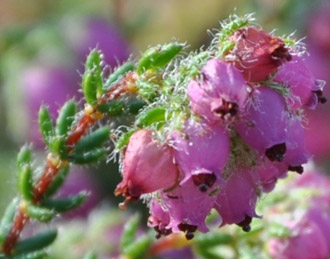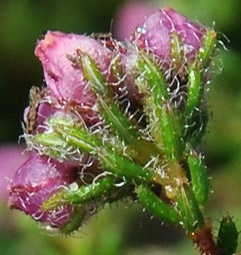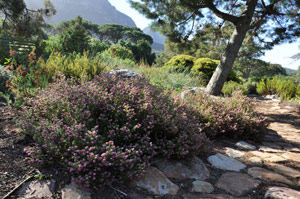Erica clavisepala
Erica clavisepala Guthrie & Bolus
Family: Ericaceae
Common names: club heath, Cape Point marsh heath
Introduction
Erica clavisepala is a rare decorative little heath, well suited to fynbos gardens and those on the sandy flats.

Description
Description
Erica clavisepala is a compact, bushy shrublet reaching only 300 mm in height. The whole plant is covered with light greyish gland-tipped hairs, giving it a distinctive frosted look and making it a bit sticky to the touch. The leaves are dark green, tiny, covered in the gland-tipped hairs, and carried in groups of four up the stem.
The flowers are dark purplish pink and are presented in dense heads of 6-20 flowers during late summer to autumn (February-April). The corolla is small (3 mm long) and urn-shaped. The bracts and sepals are long and thin and covered in long, shaggy hairs.

Conservation Status
Status
Erica clavisepala is Rare, meaning that it has a small natural population and a small distribution range. It consists of less than 20 000 individual plants and occurs over 45 square kilometers. Rare species are at risk from sudden or unexpected changes to their habitat in that a single event could wipe out the whole species. However, this heath is protected within the Table Mountain National Park and is not threatened.
Distribution and habitat
Distribution description
Erica clavisepala is endemic to the Cape Peninsula where it is confined within the Cape Point section of the Table Mountain National Park. It grows in sandy, peaty marshes and seeps on flats at low altitude and is frequent where it does occur. In the field, this heath is quite inconspicuous, due to its short stature, dark green leaves and dark purple flowers.
Derivation of name and historical aspects
History
The genus Erica gets its name from the Greek word ereiko, to break, either because of the ability of the plant to break up bladder stones or more probably because the stems are brittle and break easily. This species is so named because its sepals are slightly club-shaped, from the Latin clava, meaning club.
Ecology
Ecology
Erica clavisepala is probably pollinated by insects.
Uses
Use
Erica clavisepala is not used in traditional medicine, nor is it cultivated for the cutflower market. It makes an attractive pot plant and garden plant.

Growing Erica clavisepala
Grow
Grow Erica clavisepala in well-drained soil, in a sunny position. It prefers a well-watered site, but it must be well-drained. Grow it in the fynbos garden, gardens on the coast or on the sandy flats, in the rockery, on terraces, or in containers. When growing ericas in containers, it is important to use the correct soil. It should be a well-drained, acidic (pH between 5 and 6.5), sandy loam, containing 50% well rotted compost, with no manure or strong fertiliser (use slow release or low doses).
Propagate by seed or cuttings. Sow in late summer to autumn (March-May), in well-drained sandy soil. Keep warm and moist. Treatment with Instant Smoke Plus Seed Primer will enhance germination. Use a well-drained, acidic medium. Because the seed is so fine it needs only a light covering of clean sand, or the seeds can be mixed with dry sand and the layer of seed and sand spread in a thin layer on top of the sowing medium. Water with a fine rose to avoid displacing the seeds. Keep the trays damp but not wet and out of direct sun in a warm, but not hot, situation. Germination takes 1 to 2 months. Transplant the seedlings when they are about 10 mm high. Grow on in light shade until they are established.
Take semi-hardwood heel cuttings in late summer, autumn or spring. Treat with a rooting hormone suitable for semi-hardwood cuttings. Place in well-aerated medium, under mist on heated benches ( 24°C). Pot the rooted cuttings in a well-drained, acidic soil medium and harden off in light shade for a month or two.
References
- Goldblatt, P. & Manning, J.C. 2000. Cape plants. A conspectus of the Cape Flora of South Africa. Strelitzia 9. National Botanical Institute, Pretoria & Missouri Botanical Garden Press, Missouri. Oliver, I. & Oliver, T. [E.G.H.] 2000. Field guide to the ericas of the Cape Peninsula. Protea Atlas Project, National Botanical Institute, Cape Town.
- Plants of southern Africa: an online checklist. http://posa.sanbi.org
- Raimondo, D., Von Staden, L., Victor, J.E., Helme, N.A., Turner, R.C., Kamundi, D.A. & Manyama, P.A. (eds) 2009. Red List of South African plants 2009. Strelitzia 25. South African National Biodiversity Institute, Pretoria.
- Schumann, D., Kirsten, G. & Oliver, E.G.H. 1992. Ericas of South Africa. Fernwood Press, Cape Town.
- Trinder-Smith, T. 2006. Wild flowers of the Table Mountain National Park. South African Flower Guide 12. Botanical Society of South Africa, Cape Town.
Credits
Alice Notten
Kirstenbosch National Botanical Garden
December 2011
Plant Attributes:
Plant Type: Shrub
SA Distribution: Western Cape
Soil type: Sandy
Flowering season: Late Summer, Autumn
PH: Acid
Flower colour: Purple, Pink
Aspect: Full Sun
Gardening skill: Average
Special Features:
Horticultural zones










Rate this article
Article well written and informative
Rate this plant
Is this an interesting plant?
Login to add your Comment
Back to topNot registered yet? Click here to register.